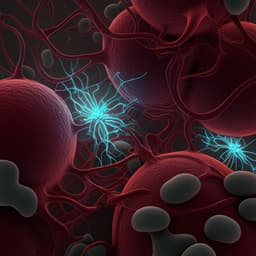
Medicine and Health
Sniffing oxytocin: Nose to brain or nose to blood?
S. Yao, Y. Chen, et al.
This intriguing study by Shuxia Yao and colleagues unveils how intranasally administered oxytocin influences brain activity and behavior, revealing the importance of peripheral routes in its effects. With significant findings on neural dynamics, it invites a deeper understanding of oxytocin's role in our physiology.
~3 min • Beginner • English
Introduction
The study addresses a central unresolved question in oxytocin (OXT) research: whether effects of intranasally administered OXT on brain function are mediated primarily by direct nose-to-brain delivery that bypasses the blood-brain barrier, or indirectly via increases in peripheral (nose-to-blood) concentrations. Although OXT receptors and projections are distributed throughout the brain, classical work indicates minimal BBB permeability to peripheral OXT. Intranasal routes may enable direct CNS access via olfactory/trigeminal pathways, but accumulating animal and human evidence also shows behavioral and neural effects following routes that should not allow direct brain entry (e.g., intravenous, subcutaneous, oral). Clarifying the relative contributions of these routes is essential for optimizing therapeutic translation. The present study uses a nasal vasoconstrictor (VC) pretreatment to limit peripheral absorption of intranasal OXT and tests consequent effects on resting-state EEG delta–beta cross-frequency coupling (CFC), alongside physiological indices and plasma OXT levels.
Literature Review
Prior research demonstrates: (a) limited BBB permeability to peripheral OXT (<0.1%) in early animal work; (b) intranasal administration can elevate OXT in CSF and blood, with proposed direct entry via olfactory/trigeminal pathways bypassing the BBB; (c) animal and some human studies show that intravenous, subcutaneous, intraperitoneal, and oral OXT can modulate behavior and brain activity, suggesting a role for peripheral mechanisms. Comparisons of intranasal vs oral OXT in humans have shown either similar behavioral/attentional and anxiolytic effects or divergent regional brain responses, indicating complexity in route-dependent mechanisms. Collectively, literature leaves unresolved the extent to which intranasal OXT effects depend on direct nose-to-brain delivery versus peripheral increases, motivating the current experimental manipulation via vasoconstrictor pretreatment.
Methodology
Design: Randomized, placebo-controlled, double-blind, between-subjects study. Participants: 96 healthy adult males, instructed to abstain from smoking/alcohol for 24 h. Power analysis (G*Power v3.1; f=0.25, α=0.05, power=0.8) indicated adequacy for detecting changes in plasma OXT and delta–beta CFC. Randomization: Participants assigned to one of three treatment arms with pretreatment and main treatment: (1) VC + OXT; (2) PLC + OXT; (3) VC + PLC. Blinding: Participants blinded to VC vs PLC pretreatment and OXT vs PLC main treatment; end-of-study guess at pretreatment was at chance (χ2=2.47, p=0.16). Final sample after exclusions: VC+OXT n=31; PLC+OXT n=31; VC+PLC n=30. Ethics: Approved by the institutional ethics committee (University of XXX, China); preregistered (registry ID not provided). Treatments: Vasoconstrictor (VC) intranasal pretreatment (4 sprays; administered 10 min before main treatment) vs placebo (0.9% saline, 4 sprays). Main treatment 10 min later: intranasal oxytocin (OXT; 24 IU) vs placebo (0.9% saline). Administration followed a standardized protocol with specified spray counts per nostril. Experimental timeline and sampling: An indwelling venous catheter enabled 8 blood draws (5 mL each) into EDTA tubes: two baseline samples 15 min apart, then six post-treatment samples every 15 min. During each 15-min interval (Rest 1–7), participants sat quietly fixating and resting. EEG acquisition: Resting-state EEG (rsEEG) recorded with 64-channel ActiChamp (Brain Products), 500 Hz sampling. Preprocessing via EEGLAB v2019.0. Spectral power computed for delta (1–4 Hz), low beta (13–25 Hz), and high beta (25–35 Hz). Regional averaging across Fp2 (prefrontal), F3/F4 (frontal), C3/C4 (central), P3/P4 (parietal), T7/T8 (temporal), O1/O2 (occipital) per 10–20 system. Cross-frequency coupling (CFC): Power-based connectivity computed as delta–beta coupling inter-regionally (all pairs among six regions; 30 pairs) and intra-regionally (six regions), Spearman correlations Fisher z-transformed for statistics. Phase-amplitude coupling (PAC) analyzed using Canolty et al. traditional method. Physiological measures: Recorded with BIOPAC MP150 at 100 Hz; measures included electrodermal activity/skin conductance (SCR/SCL) and ECG-derived indices (e.g., HRV; amplitude and cycle length). Processing via AcqKnowledge v4.4 with manual/visual inspection. Statistical analyses: Repeated-measures ANOVAs assessed treatment, time, and interactions for plasma OXT, global/inter- and intra-regional delta–beta CFC, frequency band power, PAC, and physiological indices. Post hoc tests probed significant interactions. One-tailed Spearman correlations tested time-locked associations between increases in plasma OXT (vs baseline) and increases in CFC (vs baseline) at corresponding rests/samples.
Key Findings
- Plasma OXT: Intranasal OXT (PLC+OXT) significantly increased plasma OXT from 15 to 60 min post-treatment relative to VC+PLC; VC pretreatment (VC+OXT) greatly reduced the typical OXT-induced peripheral increase, largely eliminating differences from VC+PLC except for a small increase at 15 min.
- EEG delta–beta CFC: Intranasal OXT (PLC+OXT) produced robust, widespread increases in delta–beta CFC beginning around 30 min post-treatment, with significant effects most consistently at Rest 4 (≈45 min). A significant treatment×time interaction was reported for global delta–beta CFC (e.g., F(6,4401)=2.43, p=0.008). Post hoc: PLC+OXT > VC+PLC (p=0.001) and PLC+OXT > VC+OXT (p=0.003) at Rest 4; no significant differences between VC+OXT and VC+PLC (p>0.99). Similar patterns held for inter- and intra-regional CFC.
- Correlations plasma OXT–CFC: Following PLC+OXT only, increases in plasma OXT correlated positively with increases in CFC at matched times. Rest 3: global r=0.378, p=0.018; inter-regional r=0.343, p=0.036; intra-regional r=0.503, p=0.002. Rest 4: global r=0.406, p=0.012; inter-regional r=0.296, p=0.053 (trend). No significant correlations in VC+OXT or VC+PLC; no baseline correlations across groups.
- Frequency band power and PAC: No significant treatment effects on delta, beta, or high-beta power, nor on delta–beta PAC (all ps ≥ 0.141/0.149).
- Physiological (parasympathetic/vagal indices): No significant treatment effects on SCL, HRV, or ECG indices (all ps ≥ 0.127).
- Regional nuances: While global CFC effects were eliminated by VC, a few isolated regional CFC increases in VC+OXT vs VC+PLC appeared at early time points, suggesting limited potential direct-entry effects.
Discussion
Findings support that the predominant neural effects of intranasal OXT on resting-state EEG delta–beta CFC are mediated via increases in peripheral OXT concentrations rather than direct nose-to-brain delivery. Vasoconstrictor pretreatment effectively blunted peripheral OXT elevations and abolished most OXT-induced enhancements in global, inter-, and intra-regional delta–beta CFC. Positive, time-locked correlations between plasma OXT and CFC further implicate peripheral concentrations as a critical driver of neural modulation. Limited, early regional CFC effects persisting under VC raise the possibility of small direct-entry contributions. The absence of effects on frequency power, PAC, and autonomic indices suggests delta–beta CFC is a sensitive EEG biomarker for intranasal OXT’s neural impact. These results have translational implications: (1) therapeutic effects following intranasal OXT may often be mediated by peripheral routes; (2) VC pretreatment can be a useful probe to parse central vs peripheral contributions and could minimize unintended peripheral exposure to intranasal therapeutics; (3) mechanistic pathways may include transport across the BBB (e.g., RAGE-mediated) or peripheral receptor actions influencing brain function (e.g., gut–brain signaling), warranting further investigation.
Conclusion
The study introduces a vasoconstrictor pretreatment strategy to experimentally dissociate peripheral from direct central contributions of intranasal oxytocin. Intranasal OXT robustly increased delta–beta EEG CFC and plasma OXT; VC pretreatment substantially reduced plasma OXT increases and abolished most CFC effects, with CFC changes positively correlating with plasma OXT only when peripheral increases were allowed. These findings indicate that peripheral, vasculature-mediated mechanisms are primarily responsible for intranasal OXT’s neural effects at rest. Future work should (a) directly test mechanistic pathways (e.g., RAGE-mediated transport, vagal/gastrointestinal routes), (b) include females and diverse populations, (c) examine task-related neural and behavioral outcomes, (d) refine temporal sampling to capture early direct-entry effects, and (e) assess dose–response and alternative administration routes (oral, intravenous) in parallel to intranasal.
Limitations
- Sample limited to healthy adult males; limits generalizability and excludes known sex differences in oxytocin responses.
- Resting-state EEG only; no task-based measures to link neural changes with behavior.
- Eyes-open/eyes-closed specifics and their effects are not fully explored; prior work suggests condition-dependent effects.
- VC pretreatment reduced but may not have entirely eliminated peripheral OXT increases, complicating isolation of direct-entry effects.
- No direct measurements of central OXT concentrations; mechanistic inferences (e.g., BBB transport via RAGE, vagal pathways) remain indirect.
- Physiological autonomic measures showed null effects; sensitivity and measurement conditions may limit detection.
- Some data losses/exclusions during recording reduced final sample sizes per group.
Related Publications
Explore these studies to deepen your understanding of the subject.







